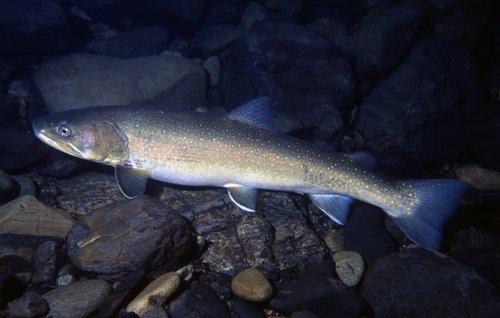
Bull Trout
The Atlantic bluefin tuna (Thunnus thynnus) is a magnificent, highly migratory species of tuna found in the Atlantic Ocean. Renowned for its size, speed, and commercial value, it plays a crucial role in marine ecosystems and human economies. It faces significant conservation challenges.
5 20 years
Lifespan
40 - 80 cm
Length
Vulnerable
Conservation Status
25 km/h
Swimming speed
Carnivorous, Insectivorous
Diet
Local Migration, Diadromous Migration - Anadromous
Migration
Appearance Overview
The Atlantic bluefin tuna is a large, torpedo-shaped fish with a metallic blue-black back and a silvery-white underside.
Coloration
Dark metallic blue on top, silvery-white underside
Body Shape
Torpedo-shaped, streamlined for speed
Fins
Two dorsal fins, the first is depressible; small finlets run from the second dorsal and anal fins to the tail
Keel
Strong lateral keel on the caudal peduncle
Length
Up to 13 feet (4 meters)
Weight
Up to 2,000 lbs (907 kg)
Diet
Carnivorous, feeding on a variety of fish, squid, crustaceans, and eels.
Feeding Behavior
Aggressive predator that uses its speed and powerful muscles to chase down prey. They often hunt cooperatively, herding and trapping schools of smaller fish.
Social Behavior
Highly migratory, forming large schools, particularly during spawning season. They exhibit complex social behaviors, including coordinated hunting.
Commercial Relevance
Extremely high value, especially in sushi and sashimi markets, where a single fish can be sold for hundreds of thousands or even millions of dollars.
Conservation measures
International fishing quotas, seasonal closures, minimum size limits, and efforts to reduce bycatch. Organizations like ICCAT play a key role in managing stocks.
Status
Endangered (Varies by stock; some populations are recovering, while others remain depleted.)
Threats
Overfishing (historically the biggest threat), bycatch in fisheries targeting other species, climate change affecting prey distribution and spawning grounds, and illegal fishing.
Habitat Distribution
Depth Range
0-1,000 meters (0-3,280 feet), but most commonly found in the upper 200 meters.
Geographic Range
Western and Eastern Atlantic Ocean, Mediterranean Sea, and formerly the Black Sea.
Preferred Environment
Temperate and subtropical waters; pelagic (open ocean) environments, often near continental shelves and slopes.
Reproduction and Life Cycle
Breeding Habits
Spawns in warm waters, with two main spawning grounds: the Mediterranean Sea and the Gulf of Mexico. Spawning typically occurs from April to June in the Gulf of Mexico and from May to July in the Mediterranean.
Development Stages
Eggs are pelagic (free-floating) and hatch into larvae. Larvae are planktonic and undergo rapid growth. Juveniles develop into adults, continuing to grow and mature over several years.
Fecundity
Highly fecund; a single female can produce up to 30 million eggs per spawning season, releasing them in batches.
Maturity Age
Matures at 4-8 years, with variations between western and eastern Atlantic populations (western populations mature later).
Faqs about Bull Trout
Where are Atlantic bluefin tuna found?
Atlantic bluefin tuna are found in the Atlantic Ocean, both in the western and eastern parts, and also in the Mediterranean Sea.
How far do Atlantic bluefin tuna migrate?
They are highly migratory and can travel thousands of miles across the ocean. They are known to cross the Atlantic in under 60 days.
What do Atlantic bluefin tuna eat?
Atlantic bluefin tuna are apex predators, meaning they are at the top of the food chain. They primarily feed on smaller fish, squid, and crustaceans.
How fast can Atlantic bluefin tuna swim?
They are among the fastest fish in the ocean, capable of reaching speeds up to 43 mph (70 km/h) in short bursts.
How long do Atlantic bluefin tuna live?
Atlantic bluefin tuna can live for up to 40 years, although most live to around 15-25 years.
Are Atlantic bluefin tuna endangered?
Yes, overfishing has severely depleted their populations, leading to their endangered status.
Are Atlantic bluefin tuna used for food?
Yes, they are highly prized for their meat, particularly in Japan for sushi and sashimi. This high demand has driven overfishing.
What is being done to protect Atlantic bluefin tuna?
Conservation efforts include strict fishing quotas, size limits, and international agreements to manage and monitor tuna populations.
When do Atlantic Bluefin Tuna reach maturity?
They can reach sexual maturity between 4-8 years, though there is regional variation. Western Atlantic populations tend to mature later than Eastern Atlantic populations.
Copyright @ Nature Style Limited. All Rights Reserved.
 English
English